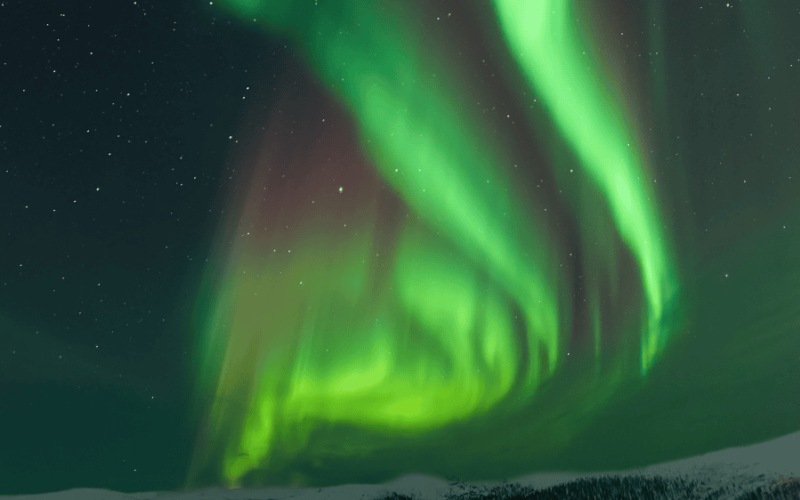In April 2019 Nenagh photographer Bridget Delaney took a Travel Department holiday to Norway, where her stay exceeded all expectations.
Fjords of Norway holiday
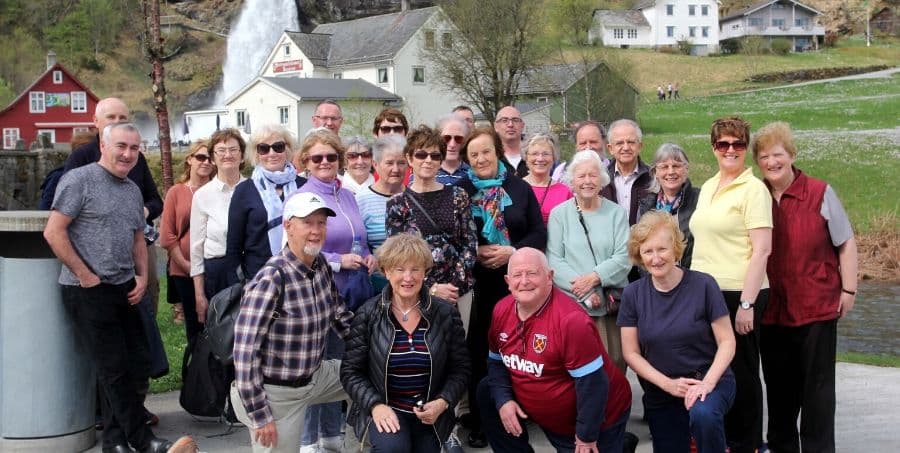
Group photo overlooking Steinsdalsfossen Waterfall at Steine Village in the municipality of Kvam in Hordaland county. The waterfall is located about two kilometres west of the large village of Norheimsund and settled along Hardangerfjorden.
I travelled to Norway with a group arranged by an Irish company called Travel Department entitled 'Fjords of Norway'. The party of 29 departed Dublin Airport with Norwegian Airlines arriving two hours later in Norway’s capital, Oslo. My one week stay exceeded all expectations. We witnessed amazing sites such as travelling on a train that took a 180 degree turn inside a tunnel (Flam Railway); travelling as a bus passenger experiencing a 360 degree turn in a tunnel going upwards in the Hardangervidda Mountain Plateau; a roundabout at road tunnels separated by Hardanger Bridge measuring 1,380 metres; travelling along steep roads by bus, train or metro with no room for driver error, overlooking steep inclines and absolutely breathtaking landscapes. I was particularly impressed by the lifestyle and attitude of Norwegians (more on this later!). The weather was unusually warm for the time of year reaching the low twenties, with our guide Andrew Hutter stating that he had never experienced such good weather in April, but guess what - the rain came thundering down for our journey back to Oslo Airport on May Day!
Beautiful Fjords
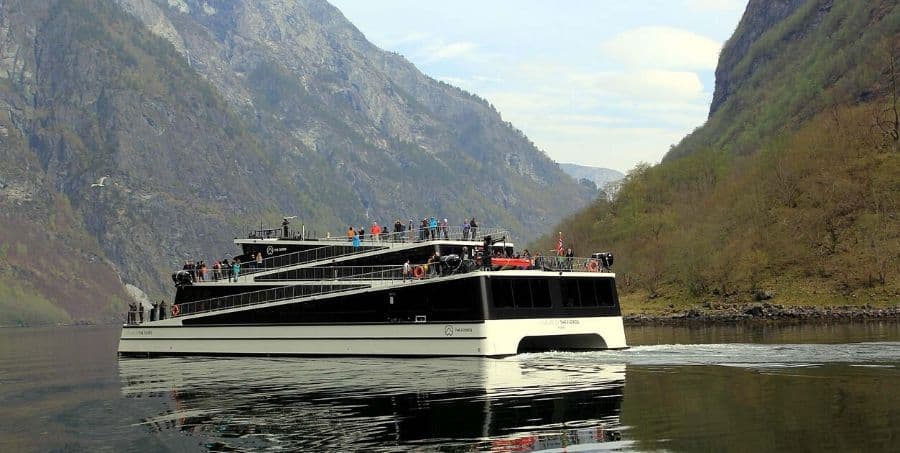
A Ferry travelling along Aurlandsfjord and Naeroyfjord which are fingers of the world famous Sognefjord.
The fjords of Norway are of course world famous. Fjords are found in locations where current or past glaciation extends below sea level and meets with the sea water. The glacier then retreats after carving a u-shaped valley, with the sides steep and bottom flat. The opening towards the sea is called the mouth of the fjord and is usually shallow with the ocean coming to meet the fresh water thus rendering a salty taste. If the geological formation is wider than long, it is not a fjord but rather a bay or cove. Killary Harbour is the only fjord we have in Ireland extending 16 km (10 miles) long, located along the Wild Atlantic Way in Connemara separating the counties of Galway and Mayo. Our group spent the first night in the high tech Clarion Hotel The Hub in central Oslo where just four hours sleep were allowed, as we had to board the Bergen Line train at the nearby Central Station at 8.20 am the following day. The scenic views over the first 5 hours prepared us for the eventful week ahead. We saw waterfalls, rivers, mountains, valleys and villages of all sorts, before arriving at snow-capped Myrdal Station. Here, we boarded the world famous Flam Railway with the best views from the seats on the left side of the train. The six carriages are each equipped with five separate brakes, each of which can stop the whole train. This is an important safety measure as Flam Railway drops 2,840 feet in under 20km (12.4 miles). The impressive engineering works on view include 20 tunnels (18 dug out by hand) which took 20 years to construct. The slow moving hydro electric train accommodated a stop at a waterfall before eventual arrival at the ‘sleepy’ village of Flam, soon to be awoken by the arrival of a big cruise ship. Here, I visited the very informative Flam Railway Museum which has free admission. The next day our group boarded the electric ferry to travel along Aurlandsfjord and Naeroyfjord which are fingers of the world famous Sognefjord, giving us the opportunity to admire the scenery before arriving at Gadvangen. An amazing bus journey then awaited us with the first stop at a waterfall, avoiding Voss by road tunnel and witnessing stunning scenery to finally reach our destination, Bergen city and municipality, in Hordaland.
Bergen walking tour

We did a City Walking Tour of Bergen accompanied by a very informative guide called Andrea. The rich history of Bryggen Wharf was recalled. The area was very well preserved and clean, as is common with all historic sites in Norway. Andrea accompanied us to the Floien Funicular, which highlights the ‘layered city’ (a feature common to other Norwegian urban areas visited), and overlooks Norway's second largest city accommodating 271,949 people. In the afternoon, I visited the Bergenhus Fortress Museum where the Swedes forced involvement in World War II was documented as Germany invaded two neutral Scandinavian countries Norway and Denmark on April 9th, 1940. On Saturday evening, many of the group went to Latin Mass in St Paul's Catholic Church and there was an even bigger congregation present at the Norwegian Mass in the same church on Sunday morning. Roman Catholicism is the second most popular religion of Norway at only 2.9% with the largest Lutheran Christianity at 71.5%.
Bus excusion from Hardangerfjord to Hardanger
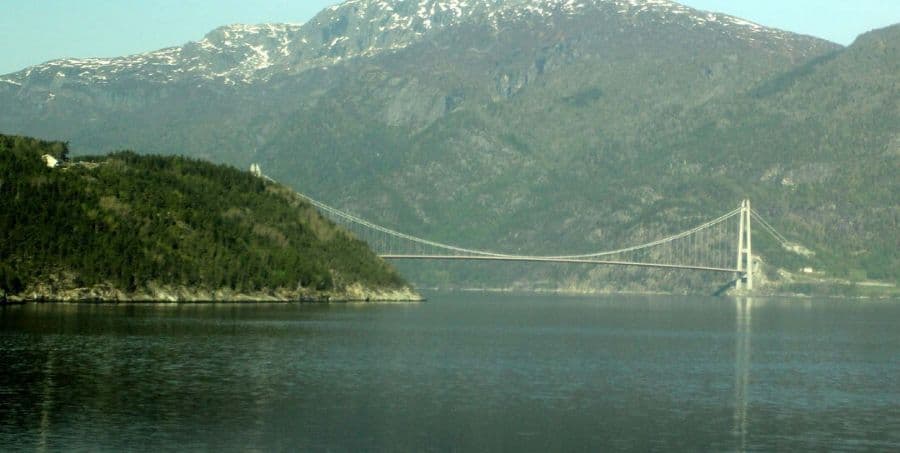
Handanger Bridge, measuring 1,380 metres.
The 139 km bus excursion 'Orchard of Norway' involved admiring the picture-postcard Hardangerfjord to Hardanger route with great engineering and craftsmanship apparent for the frequent road tunnels and crossing at Hardanger Bridge, before arriving at the picturesque village of Lofthus. This place has walking routes accompanied by signage, along with a further backdrop of stunning scenery. Here, I witnessed a Confirmation celebration which in Norway is a ceremony confirming a 15 year old boy or girl to adulthood. At 16, students make the decision to branch out their education towards either academic or trade careers. Education is free to primary, secondary and university students
Hardangervidda Nature Centre
No better way to spend a Monday than travelling a distance of 372 km from Lofthus to Oslo while experiencing a multitude of breath-taking views. We travelled through the Mabodal Valley to the Eidfjord and visited the nearby Hardangervidda Nature Centre where a 20-minute film gave us an insight into the history and geography of this region. It was a privilege to journey up and down the Hardangervidda Mountain Plateau with our party flabbergasted by the road tunnels that shortened considerably the upward climb. On the descent, the snow was melted in the valleys while the lakes mirrored reflections of the landscape. Eventually we reconnected with the towns that we passed on the Bergen Line train journey and stopped in Gol for lunch. We branched off again from the Railway Line (which took a longer route). More stunning lakes amused our eyes and finally we arrived at the centre of Oslo approaching 5pm. Oslo is the capital city with 634,293 inhabitants, it is structured in layers and extends as far as the mountains and is situated at the head of Oslofjord. It is renowned for its green spaces. Parking is mainly underground and road tunnels also help to free any congestion. We did a Walking Tour with our well-informed guide Andrew Hutter. The purchase of the 24-hour Oslo Pass was an attractive option in order to visit the numerous Museums catering for a variety of interests, but I chose to avail of the sunshine and enjoy some outdoor pursuits.
My own mystery tour in Oslo

A bird's eye view of city of Oslo.
So, that afternoon I did my own mystery tour which began by witnessing of the ‘Changing of the Guard’ outside the Royal Palace at 1.30pm. I then used the Metro for the next three destinations. Firstly, I visited the 28,000 all-seater Ullevaal Stadium, which is the home ground of the Norway national soccer team owned by the Norway Football Association. This ground is not open to the public except on match days but thanks to the Conference Centre Manager I got to sit on the soft seats in the VIP Section! Next, I went to Vigeland Park which is the largest sculpture park in the world with over 200 pieces by a local sculptor, Gustav Vigeland. Finally, I headed for the hills - to Holmenkollen National Arena, a Nordic skiing and biathlon venue and, from there, enjoyed a panoramic view of Oslo. May Day is also a national holiday in Norway with many places closed, with the exception of tourist locations and thankfully the Viking Ship Museum was open, where I enjoyed exhibits such as the Oseberg Ship, Gokstad Ship, Tune Ship and other artefacts. This museum and many more are located on the western side of Oslo, at Bygdoy Peninsula.
Norway the country and its people
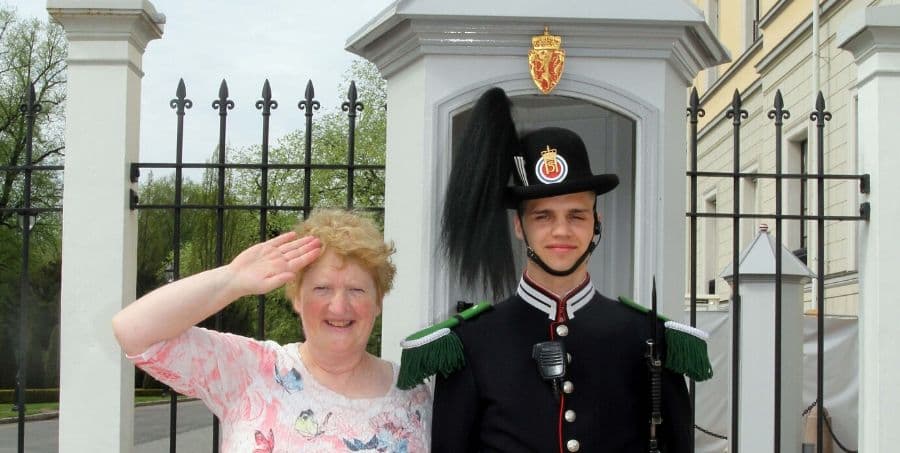
After the Changing of the Guard ceremony was completed.
Norway is sparsely populated with 5,312,300 inhabitants spread over a total area of 385,207 square kilometres (148,729 square miles). Norwegian people love their country, are well paid and happy to pay high taxes with a ceiling of 45 per cent, in return for a high standard of services provided in education, health and infrastructure. I found them to be friendly, not driven by greed and will leave no stone unturned when it comes to the betterment of their country. An average employee in Norway works five days a week, almost 7 hours a day, amounting to 33.4 hours per week with commuting time to work averaging 32 minutes per day. They will leave on time as rushing is not conducive to their easy-going nature. They are not intrusive but will go out of their way to assist tourists when approached. Norwegians are conscious of their health and generally eat healthy food. They like to keep fit and enjoy outdoor activities such as hiking, skiing and fishing. It is not unusual for Norwegians to have a cabin in the mountains or at the coast and sometimes in both places, in order to pursue outdoor activities in their down-time. They are family orientated, often retreating to the countryside at the weekends to chill out. They do not appear to be driven by material wealth. Norwegians may enjoy a few drinks at the weekend, generally with meals or at house parties. However, drink-driving is not tolerated. The limit is .02 with fines amounting to a month’s salary coupled with two years off the road and a re-sit of the driving test before returning. The price of a pint of beer or Guinness is around 100 Kroner (€10). Norwegian Constitution Day is May 17th each year and is the national day of Norway.
Proud nation
When it comes to achievements, Norwegians are proud of their endeavours but remain grounded and do not boast about their feats. There is a fear that these traditional principals may change due to the onset of social media. Norway is a wealthy country with over a trillion assets in their Sovereign Wealth Fund. The Norwegian government is however prudent with funds and encourages all people to work. King Harold and Queen Sonja of Norway are very popular monarchs but the most important person in Norwegian politics and the head of the government is the Prime Minister, currently Erna Solberg, head of the Conservative Party. Norway is rich in natural resources which include oil, gas, copper, lead and timber with state-ownership in strategic areas. Norway is the world's third largest exporter of petroleum and is one of the 36 countries in the OECD but is not a member of the EU and is unlikely to join in the foreseeable future. Norway is a great place to live as the air is pure, the rivers run free and tap water is not only safe to drink but delicious to taste. The Norwegian Vikings first invaded Ireland in 795 and nowadays we could do with invading and adopting some of their habits. My visit to Norway was an eye opener – a true reflection of how to ‘live and let live’.
This article originally appeared in the Nenagh Guardian May 25th 2019 and the majority of photos were taken by Bridget Delaney.


